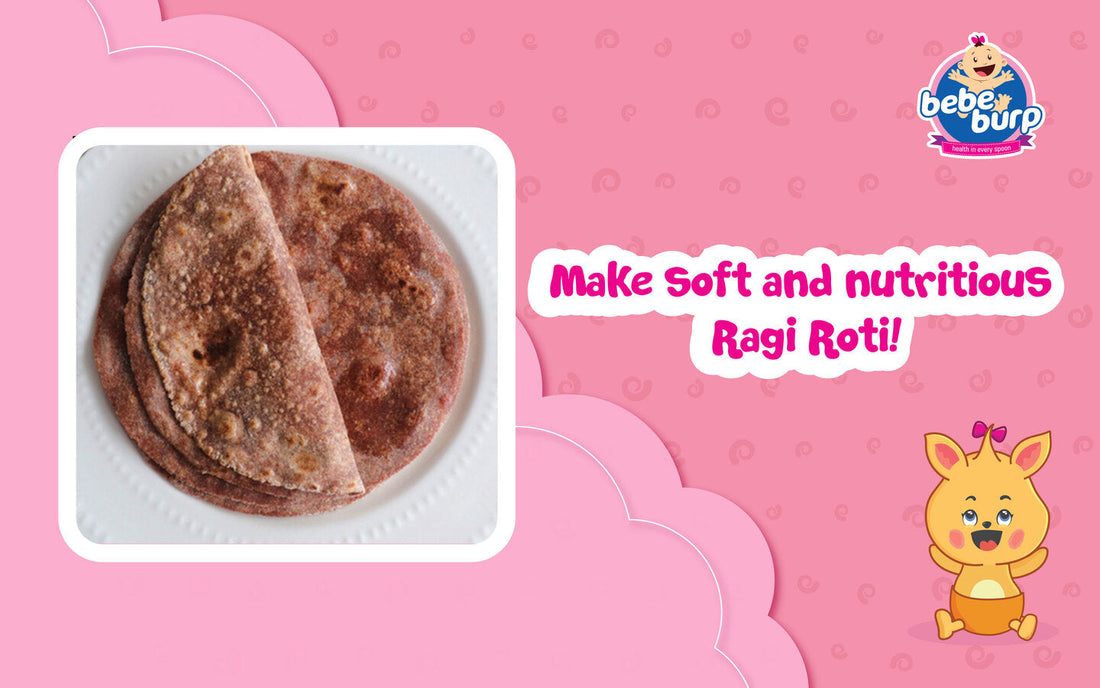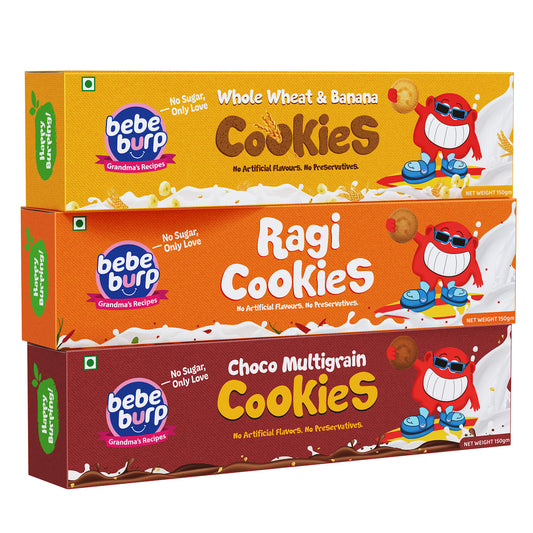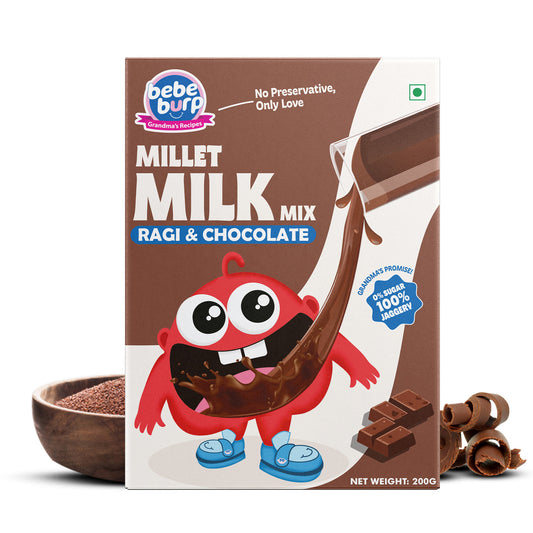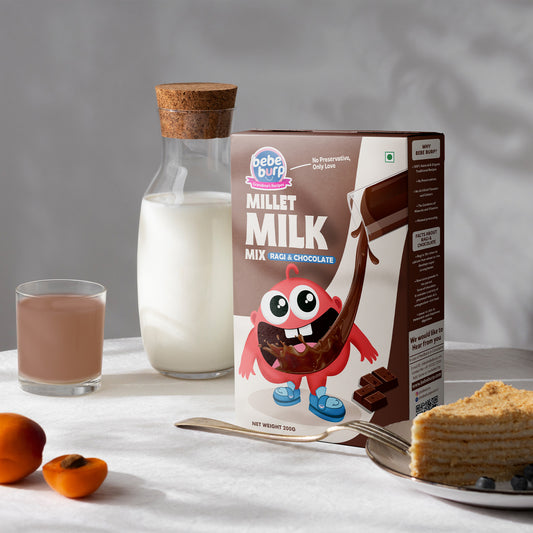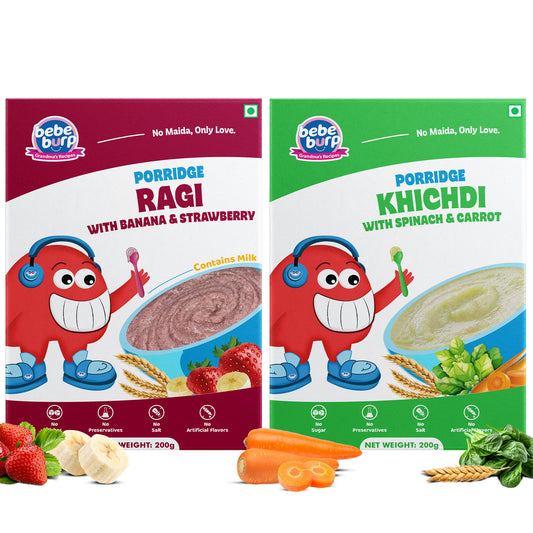INTRODUCTION
Ragi roti, popularly known as finger millet flatbread, is a constant in the diet charts of growing babies. It is widely used during mealtimes owing to its numerous health benefits and nutritional value that helps in the overall development of the growing toddler. Considering the preparation can be tricky, we have curated this best ragi roti recipe for parents to follow and prepare this delicious, nutritious meal for their kids.
This ragi roti recipe is reliable and has easy to follow instructions for parents to follow. It has accurate measurements, cooking time, and illustrations to eliminate the guesswork and minimize the chances of making mistakes. Thus, you get to serve nothing but the best for your kid.
HEALTH BENEFITS OF RAGI ROTI
- High Nutritional Value : Ragi, also known as finger millet, boasts a rich nutrient profile that makes it a highly nutritious grain. It is an excellent source of dietary fiber, which aids in digestion, promotes satiety, and helps regulate blood sugar levels. Additionally, ragi is abundant in calcium, providing a significant boost to bone health and preventing conditions like osteoporosis. It is also a noteworthy source of iron, essential for oxygen transport and preventing anemia. Furthermore, ragi contains a substantial amount of protein, making it a valuable plant-based protein option for vegetarians and vegans. Its impressive nutrient content makes ragi a wholesome and nourishing grain choice with a range of health benefits that is a noteworthy addition to your toddler’s diet.
- Gluten-Free Alternative : Ragi roti is an excellent option for babies with gluten sensitivity or celiac disease due to its gluten-free nature. Unlike wheat-based rotis, which contain gluten, ragi is naturally devoid of this protein composite. This makes ragi roti a safe and healthy alternative for those who need to avoid gluten in their diet. By incorporating ragi roti, babies with gluten sensitivity or celiac disease can still enjoy a nutritious and wholesome flatbread without worrying about adverse reactions or damage to their digestive system. It allows parents to diversify their kids' meals so that they can enjoy the benefits of ragi's nutrient-rich composition, including fiber, calcium, iron, and protein, while adhering to the gluten-free dietary requirements.
- Weight Management : Ragi roti's high fiber content makes it beneficial for weight loss and promoting satiety, even in babies. The fiber in ragi aids weight loss by promoting a feeling of fullness and reducing appetite. When consumed, the fiber absorbs water and expands in the stomach, creating a sense of satiety and reducing the tendency to overeat or snack on unhealthy foods. This helps in managing calorie intake and controlling weight. Additionally, the high fiber content in ragi roti aids in regulating bowel movements, preventing constipation, and maintaining a healthy digestive system in babies. The inclusion of ragi roti in their diet can provide the necessary fiber intake, contributing to their overall satiety, healthy growth, and development.
- Blood Sugar Regulation : Ragi has a low glycemic index (GI), which makes it a favorable choice for managing blood sugar levels, including in babies. The low GI of ragi means that it releases glucose into the bloodstream at a slower pace compared to high-GI foods. This gradual release helps prevent sudden spikes in blood sugar levels and provides a steady and sustained source of energy. For babies, this is particularly important as their developing bodies require stable blood sugar levels for optimal growth and development. Including ragi in their diet helps regulate blood sugar levels, reducing the risk of blood sugar fluctuations. This can be beneficial in preventing conditions like diabetes and promoting overall metabolic health. Moreover, the slow release of glucose from ragi also contributes to a feeling of fullness, preventing excessive hunger and potential overeating.
INGREDIENTS REQUIRED
Follow this ragi roti recipe to make the perfect meal for your kid!
Ragi Roti Ingredients:
- 1/2 cup ragi flour (finger millet flour)
- 1/4 cup water (adjust as needed)
- A pinch of salt (optional)
- Ghee or oil for cooking
Note: Using good quality ragi flour as the ragi roti ingredient is crucial for ensuring the nutritional benefits and overall taste of ragi roti. High-quality ragi flour is made from clean, properly processed finger millet grains, which retains the maximum nutrients and flavor. It is important to source ragi flour from reliable and trusted sources to ensure its purity and quality. Thankfully, ragi flour is widely available in local markets, grocery stores, and even online platforms. Many health food stores also stock ragi flour due to its increasing popularity. By choosing a reputable brand such as Bebe Burp or supplier, parents can easily find good quality ragi flour, making it convenient to incorporate this nutritious ingredient into their baby's diet and enjoy the benefits of ragi roti.
STEP BY STEP RECIPE INSTRUCTIONS
Follow the step by step ragi roti recipe to prepare delicious rotis:
- In a mixing bowl, combine the ragi flour and salt (if using).
- Slowly add water to the flour while stirring continuously to form a smooth and soft dough. Adjust the amount of water as needed to achieve the desired consistency.
- Once the dough is formed, cover it and let it rest for about 10-15 minutes to allow the ragi flour to absorb the moisture.
- Divide the dough into small portions and roll each portion into a small ball.
- Take one dough ball and flatten it between your palms to form a small disc.
- Place the flattened dough on a clean surface or a rolling board dusted with ragi flour.
- Using a rolling pin, gently roll out the dough into a thin roti, approximately 4-5 inches in diameter.
- Heat a tawa or a non-stick skillet over medium heat. Place the rolled roti on the heated tawa.
- Cook the roti for about a minute on one side until small bubbles start to appear.
- Flip the roti and cook the other side for another minute until it turns golden brown.
- Apply a little ghee or oil on both sides of the roti to keep it soft and moist.
- Repeat the process for the remaining dough balls to make more ragi rotis.
- Once cooked, allow the ragi rotis to cool down slightly before serving them to your baby.
- Cut the ragi rotis into bite-sized pieces or strips for easy handling by your little one.
- Serve the ragi roti with a mild vegetable curry, lentil soup, or yogurt for a wholesome meal.
Note: Remember to always consult with your pediatrician before introducing new foods into your baby's diet, including ragi roti, to ensure it aligns with their specific dietary needs and any allergies or sensitivities they may have.
SERVING SUGGESTIONS AND VARIATIONS
Accompaniments:
To complement the ragi roti for babies, here are some popular side dishes that can be served:
- Coconut Chutney: A mild and flavorful coconut chutney made with fresh coconut, roasted gram dal (chana dal), and a touch of yogurt. It provides a creamy texture and a subtle coconut flavor that pairs well with the earthy taste of ragi roti.
- Tomato Curry: A simple tomato curry prepared with ripe tomatoes, gentle spices, and a hint of sweetness. This tangy and mildly spiced curry adds a burst of flavors and complements the nuttiness of ragi roti.
- Lentil Soup: A protein-rich lentil soup, such as moong dal or masoor dal, cooked with minimal spices and a touch of ghee or butter. This comforting and nutritious soup can be served alongside ragi roti, offering a balanced meal for your little one.
- Yogurt: Plain, unsweetened yogurt is an excellent accompaniment to ragi roti. It provides a cooling effect and adds a creamy element to the meal. You can also mix in a pinch of roasted cumin powder or finely chopped fresh coriander leaves for added flavor.
These side dishes not only enhance the taste but also provide additional nutrients to your baby's meal. As always, ensure that the side dishes are prepared using age-appropriate ingredients and follow any dietary guidelines provided by your pediatrician.
Variations:
Here are some ideas for incorporating different flavors or ingredients into the basic ragi roti recipe for babies:
- Sweet Potato Ragi Roti: Add mashed cooked sweet potatoes to the ragi flour mixture. Sweet potatoes add natural sweetness and extra nutrients to the roti.
- Carrot and Cumin Ragi Roti: Grate carrots and mix them with the ragi flour. Add a pinch of cumin powder for added flavor. Carrots provide vitamins and natural sweetness.
- Spinach and Paneer Ragi Roti: Puree cooked spinach and mix it into the ragi dough. Crumble some soft paneer (Indian cottage cheese) into the mixture for added protein and calcium.
- Beetroot and Mint Ragi Roti: Grate boiled beetroot and add it to the ragi flour. Finely chop fresh mint leaves and incorporate them into the dough. Beetroot adds natural sweetness and vibrant color, while mint adds a refreshing flavor.
- Banana Ragi Roti: Mash ripe bananas and mix them with the ragi flour to make a sweet and soft roti. This variation is great for introducing fruits to your baby's diet.
- Apple and Cinnamon Ragi Roti: Grate or finely chop an apple and mix it into the ragi flour. Add a pinch of cinnamon powder for a delightful flavor combination.
- Avocado Ragi Roti: Mash ripe avocado and combine it with the ragi flour. Avocado adds healthy fats and creaminess to the roti.
- Lentil Ragi Roti: Soak and grind any lentils of your choice, such as moong dal or masoor dal. Mix the lentil paste with the ragi flour to make protein-rich rotis.
Remember to adjust the consistency of the dough as needed by adding water or breast milk/formula to achieve the desired texture suitable for your baby. Additionally, make sure to introduce new ingredients gradually to watch for any allergies or sensitivities.
CONCLUSION
In conclusion, ragi roti offers a multitude of health benefits, including its rich nutrient profile, gluten-free nature, high fiber content, low glycemic index, and suitability for weight management. It provides essential nutrients like fiber, calcium, iron, and protein, making it a wholesome and nutritious addition to daily meals, especially for babies. The simplicity of the ragi roti recipe makes it easy to incorporate into their diet. By introducing ragi roti to their babies' meals, parents can ensure their little ones receive the goodness of this nutrient-dense grain, promoting healthy growth, digestion, and blood sugar management. So, why not give ragi roti a try and provide your babies with a delicious and nutritious meal option that contributes to their overall well-being? Embrace the benefits of ragi roti and enjoy its goodness in your daily cooking for your little ones.
ADDITIONAL TIPS
While cooking this ragi roti recipe for babies, parents may encounter some common issues. Here are some solutions to address these problems:
- Dry and Crumbly Roti: Ragi flour tends to be dry, which can result in crumbly rotis. To overcome this, you can add some mashed fruits or vegetables (like banana, sweet potato, or cooked spinach) to the dough to increase moisture content. Additionally, try adding a little ghee or oil while kneading the dough to improve the texture and prevent dryness.
- Difficulty in Rolling Rotis: Ragi flour doesn't possess gluten like wheat flour, making it challenging to roll into perfect round rotis. To make rolling easier, you can try the following techniques:
- Divide the dough into small portions and roll each portion using a rolling pin between two sheets of greased plastic wrap or parchment paper. This will prevent the dough from sticking and make it easier to handle.
- Alternatively, you can pat the dough directly onto a greased non-stick pan or use your hands to shape small rotis.
- Sticking to the Pan: Ragi rotis can stick to the pan due to the lack of gluten. To prevent sticking, make sure the pan is well-greased with ghee or oil before placing the roti on it. You can also use a non-stick pan or a cast-iron skillet to reduce the chances of sticking.
- Hard and Chewy Roti: Overcooking ragi rotis can make them hard and chewy. It's important to cook them on medium heat and for the right duration. Cook each side until it forms a golden-brown color, and avoid overcooking to retain the softness.
- Bitter Taste: Ragi flour can have a slightly bitter taste, which may not be appealing to babies. To reduce the bitterness, you can roast the ragi flour lightly before using it in the recipe. This will enhance the flavor and reduce the bitter aftertaste.
- Lack of Flavor: Ragi rotis can be relatively plain in taste. To enhance the flavor, you can add mild spices like cumin powder or a pinch of salt to the dough. Additionally, incorporating mashed fruits, vegetables, or even mild herbs like mint or coriander can add natural flavors and nutrition to the rotis.
Remember to take into account your baby's preferences and any dietary restrictions or allergies when making modifications to the basic ragi roti recipe.
FAQs
- What should be eaten with ragi roti?
For babies, ragi roti can be served with mild and soft accompaniments. You can pair it with mashed cooked lentils (dal), pureed vegetables, yogurt, or a small amount of homemade fruit puree. These options provide additional nutrients and flavors to complement the ragi roti.
- Is ragi roti good for health?
Yes, ragi roti is considered good for babies' health. Ragi (finger millet) is a nutritious grain that is easily digestible and packed with essential nutrients. It is rich in dietary fiber, calcium, iron, and other important minerals that support healthy growth and development in babies.
- When should ragi not be eaten?
Ragi is generally safe for babies to consume, but there are a few instances when it should be avoided or introduced with caution. If your baby has a known allergy to ragi, it should be avoided. Additionally, if your baby has a history of kidney stones or calcium oxalate issues, it's best to consult a pediatrician before introducing ragi into their diet.
- Can ragi flour be consumed during the summer?
Yes, ragi flour can be given to babies during the summer. While ragi is known to generate heat in the body, its consumption in moderation is generally safe for babies during summer months. Ensure that your baby stays well-hydrated and incorporate other cooling foods, such as fruits and vegetables, to balance the body's temperature.

